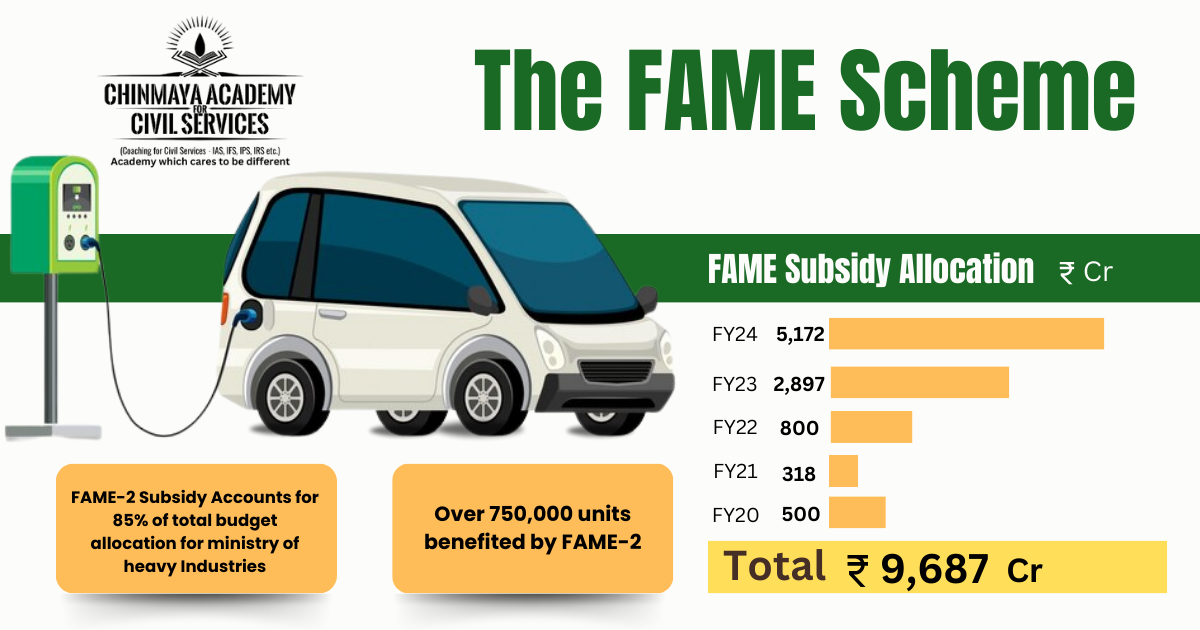
The FAME Scheme
The Faster Adoption and Manufacturing of Electric Vehicles in India (FAME) scheme has been a key driver in the country’s electric mobility journey.
Why in NEWS
Phase 3 of this scheme is expected to be launched in the upcoming Interim Budget
Historical background
2011: The seeds of FAME were sown with the National Mission on Electric Mobility (NEMMP), outlining a vision for transitioning to electric vehicles and fostering their domestic manufacturing.
April 2015: FAME Phase I rolled out, aiming to stimulate both demand and supply of electric and hybrid vehicles (HEVs) through:
- Demand incentives: Subsidies for buyers of all vehicle segments (2-wheelers, 3-wheelers, passenger cars, light commercial vehicles, and buses).
- Technology platform: Support for research and development of EV technologies.
- Pilot projects: Testing and demonstration of EVs in specific situations.
- Charging infrastructure: Promoting the development of charging stations across the country.
March 2019: FAME Phase I concludes, having:
- Supported 2.8 lakh EVs with demand incentives.
- Deployed 425 electric and hybrid buses across India.
- Sanctioned around 520 charging stations and infrastructure projects.
April 2019: FAME Phase II commences with a renewed focus on:
- Public and shared transportation electrification: Prioritizing support for e-buses, e-3 wheelers, electric passenger cars, and e-2 wheelers.
- Production Linked Incentive (PLI) Scheme: Encouraging domestic EV manufacturing through financial incentives for production and sales.
- Focus on advanced battery technology: Promoting the development and adoption of advanced batteries for EVs.
Present: FAME II continues to drive EV adoption, with ongoing progress in:
- Expanding the electric vehicle market share.
- Building charging infrastructure and mitigating range anxiety.
- Attracting investment and accelerating domestic EV production.

Future
The government is actively discussing FAME III, expected to further refine the scheme and prioritize:
- Expanding support for commercial vehicles and heavy-duty trucks.
- Incentivizing battery swapping infrastructure for faster charging.
- Promoting hydrogen fuel cell vehicles as a potential alternative.
Overall, the FAME scheme has come a long way, adapting to evolving needs and challenges. It continues to play a crucial role in shaping India’s electric mobility future, aiming for a cleaner, greener, and more sustainable transportation system.

The Annual Status of Education Report (ASER)
Annual Status of Education Report (ASER) is a nationwide household survey that captures the status of children’s enrolment and learning outcomes in rural India every year.
ASER 2023
Key findings
In rural India, the aspirations of boys and girls to become doctors or engineers are nearly equal. In actuality, there are slightly more girls than boys who want to pursue these careers.
- Overall, 16.7% of boys and 18.2% of girls wanted to be engineers or doctors.
- Just 28% of girls ultimately chose STEM courses, compared to 36.3% of boys.
- The findings are based on an ASER survey that was conducted from September to November of last year among 14–18 rural students in 28 districts.
 Chinmaya IAS Academy – Current Affairs Chinmaya IAS Academy – Current Affairs
Chinmaya IAS Academy – Current Affairs Chinmaya IAS Academy – Current Affairs
